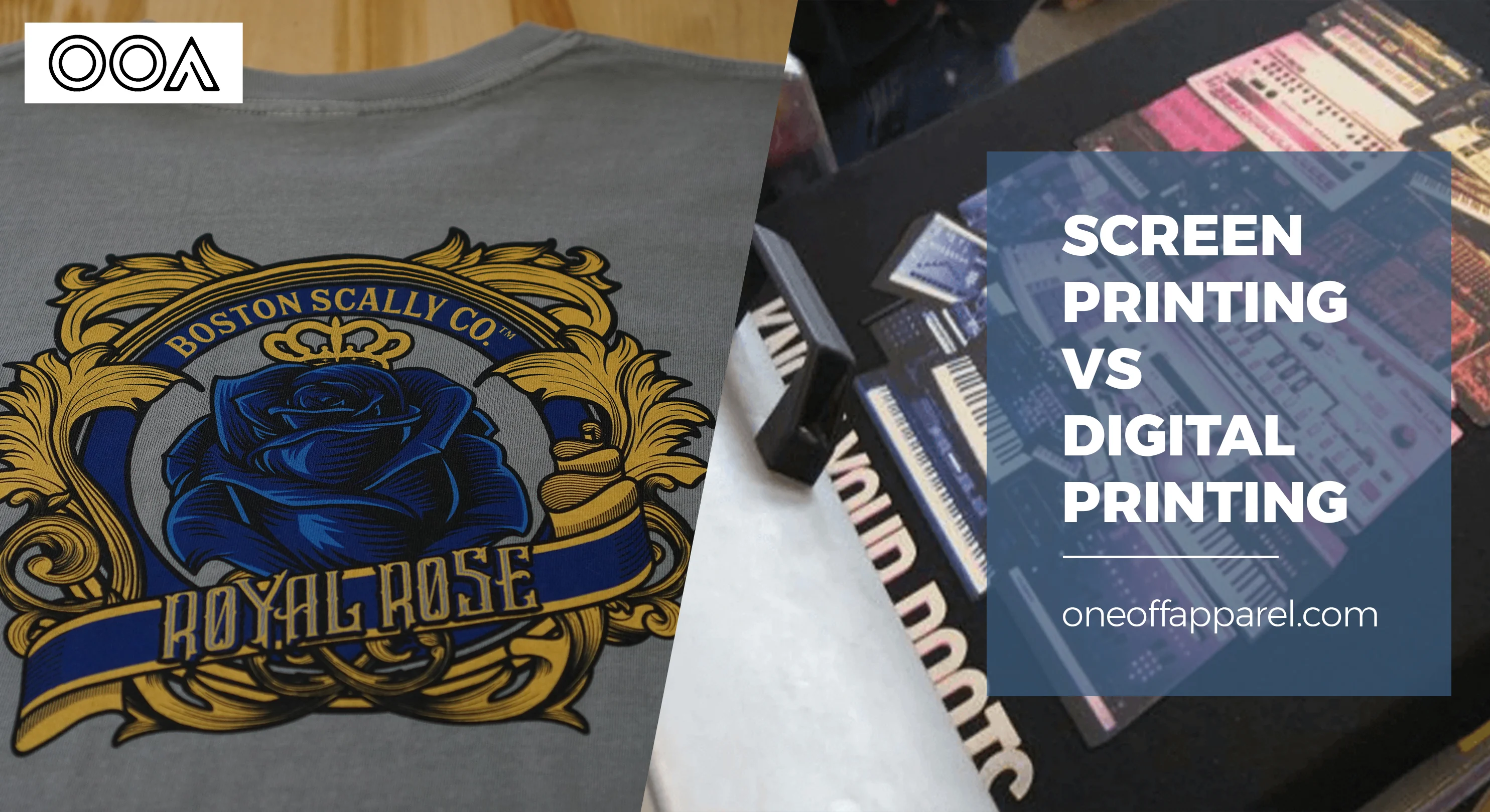
Stuck between screen printing vs digital printing for your custom t-shirts? You're not alone. This choice can make a big difference in how your final custom products looks, feels, and holds up over time. One Off Apparel knows that understanding these printings methods helps customers make smarter choices.
We provide top customer service, Let's break down what makes each technique unique and when you should pick one over the other. Screen printing vs digital printing are two popular methods for creating custom t-shirts for team members. When comparing screen printing and digital printing, artwork plays a vital role as it determines the quality, detail, and flexibility of the final product
What Is Screen Printing?
Screen printings is the tried-and-true veteran of the custom apparel world. It's been around for decades and remains incredibly popular for good reasons.
How Screen Printing Works?
Think of screen printing as using a stencil for each color in your design. Ink is pushed through a mesh screens onto your shirt, with separate screens for range of colors. The result? Thick, vivid ink that sits on top of the fabric rather than soaking in. Screen printing is a great way to create high-quality, durable prints on various types of materials, including clothing and promotional items
A screens printer applies each color one at a time using a squeegee to push ink through the screens. This hands-on process creates that distinctive thick layer of screen printing ink that screen printings is known for. Screen printing has been around for many years, and it is widely popular because of the variety of fabrics it can be used on. Custom ink is a crucial component in both screen printing and digital printing processes, as it allows for the creation of personalized designs on various surfaces with precision and vibrancy
Best Uses for Screen Printings
Screen printing shines when you need:
- Large orders of the same design (the more shirts, the cheaper each one becomes)
- Bold, simple graphics with fewer colors
- Extra-bright colors on dark shirts
- Special effects like metallic, glitter, or puff ink that literally rises off the shirt
What Is Digital Printings(dtg)?
Digital printings (often called DTG or Direct-to-Garment) is the newer technology on the block. It's like having a super-advanced inkjet printer designed specifically for t-shirts. Digital printing offers the advantage of being able to print on a wider variety of fabrics, including cotton, polyester, fleece, nylon, and blended fabrics, making it a versatile option for customized apparel
How Digital Printing Works?
With DTG printing, your design goes straight from computer to shirt. The fabric gets pre-treated with a solution, then specialized water-based inks print directly onto the garment in one pass. No screens, no separate layers for each color—just a complete design printed all at once.
Best Uses for Digital Printings
Digital printing is perfect when you want:
- Small batches or even single shirts (no minimum orders)
- Complex designs with lots of colors or photo-realistic images
- Quick turnaround time on rush orders
- No setup fees for new designs
Key Differences Compared Screen Printing vs Digital Printing
Cost Comparison :
Here's the simple truth: for small orders (less than 24 shirts), digital printings wins on price. With no setup costs, you might pay $15 - $25 per shirt. Screen printings for small batches can cost a multiple of this per shirt plus setup fees.
But the tables turn completely for large orders. Once you hit 36 or 72+ shirts, screen printings becomes significantly cheaper per shirt, while digital printings costs stay about the same regardless of quantity.
Durability & Washability :
If longevity matters, screen's printing has the edge. Those thick screens printed designs typically outlast their digital counterparts, often looking good even after 15+ washes. Digital prints might begin fading sooner, especially if washed in hot water. Screen printings is more suitable for hoodies due to its ability to create vibrant and long-lasting designs on thicker fabrics, whereas digital printings may be better suited for lighter garments like T-shirts
Screen printing is best fits for designs that require vibrant colors and long-lasting durability on fabric, while digital printing is best fits for intricate designs with many colors and small details. Screen printing is known for being durable and long-lasting, making it a popular choice for creating designs on various fabrics, especially t-shirts.
Design Complexity :
Screen printing vs Digital printing shows a clear division when it comes to detail:
Digital printings handles:
- Unlimited vibrant colors at no extra cost
- Photos and gradients
- Tiny details and small text
Screen printing excels with:
- Limited color palettes
- Bold, graphic designs
- Solid areas of color
Fabric Compatibility :
Screen printings works on almost anything—cotton, polyester, blends, and even non-fabric items like glass and wood. Digital printings performs best on natural fabrics, particularly 100% cotton. It can struggle with synthetic fabrics and dark colors. Using a heat press machine is essential in the process of transferring designs onto fabric for both screen printing and digital printing methods.
Dye is a crucial component in the screen printing process as it is what creates the vibrant colors and designs on the fabric, while dye sublimation printing utilizes heat to transfer dye onto materials such as plastic, card, paper, or fabric, resulting in high-quality images that are more durable than traditional dyeing methods
Which Printing Method Should You Choose?
Ask yourself these questions:
- How many items do you need? (Large order = screen printing advantage)
- How complex is your design? (Many colors or photos = digital advantage)
- What's your budget? (Tight budget + small order = digital)
- How important is long-term durability? (Need to last years = screen printing)
FAQs
"Does screen printing crack over time?"
Quality screen printing on appropriate fabrics shouldn't crack if properly applied. Heavyweight inks on stretchy fabrics are most prone to cracking. Proper curing during production helps prevent this issue.
"Can digital printing match Pantone colors?"
Digital printing uses the CMYK color process, which can't perfectly match all Pantone colors. Screen printing offers more precise color matching since each ink is custom-mixed to your specifications.
The screen printing vs digital printing debate doesn't have a one-size-fits-all answer. Your specific needs—quantity, design complexity, fabric choice, and budget—should guide your decision. One Off Apparel provides both methods and embroidery services because each has its place in creating fantastic custom apparel. Whichever you choose, understanding these differences helps ensure you'll be happy with the final product.
What are the differences between screen printing and digital printing?
Screen printing involves pushing ink through a stencil onto fabric, giving vibrant colors and durability for bulk printing. Digital printing, on the other hand, uses digital files to directly apply ink onto the fabric, ideal for intricate designs in smaller quantities with quick turnaround times.
The screen printing vs digital printing debate doesn't have a one-size-fits-all answer. Your specific needs—quantity, design complexity, fabric choice, and budget—should guide your decision. One Off Apparel provides both methods because each has its place in creating fantastic custom apparel. Whichever you choose, understanding these differences helps ensure you'll be happy with the final product.
Elevate your brand's presence with One Off Apparel exceptional screen printing services. Contact us today at (508) 835-8883 or email info@oneoffapparel.com to know more and start your project!
© Copyright All Rights Reserved

